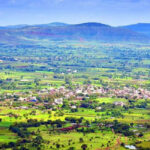The situation may, in fact, get worse in the coming months as the entire monsoon is yet to arrive.
Village Square: What has been the impact of the flood in the BTR of Assam?
Jyotishmoy and Rajdeep: BTR is made up of five districts and situated on the north bank of the Brahmaputra river below the foothills of Bhutan and Arunachal Pradesh. Due to the differences in the topographical regions, the pattern and impact of the flood varies. In the northern part with more slope, there are mostly flash floods and the water’s velocity is a lot.
Historically in Assam the flood starts in July and goes on till October. But this year it started around the 14th of May. People and resources weren’t as mobilized well in May, but in June even the urban areas were completely flooded.
However, if you move further south, close to the Brahmaputra river, inundation becomes a major problem because all the water gets collected there. Sometimes the water stays for 15-20 days and submerges everything.

This flood is the worst flood in the last 30-40 years. 34 out of 35 districts in Assam are flood affected in some way this year.
Village Square: How has it impacted human life? What are the main issues faced by the people right now?
Jyotishmoy and Rajdeep: The BTR includes several marginalized communities, landless households, and tea estate workers.
The crop loss has been a lot. The people are dependent on the boro paddy for food. The straw of the boro paddy is the main feed for the livestock. This is completely devastated in the floods and has affected the food for the people as well as for the livestock. There is water everywhere so there is no fodder as well.
Due to the floods agricultural activity is almost nil this year. The impact on livestock is also apparent; they are falling sick a lot. People’s livelihood has taken a huge hit as almost 80% of people here depend on agriculture.
There is an impact on schools as well. Many schools were turned into relief camps, while many school buildings itself were flooded. The students lost several weeks of education.

Students said that they are taking shelter at the relief camps where the environment is not conducive for studying. The ones who were at home lost their books in the floods.
Village Square: What about the impact on people’s health and safety?
Jyotishmoy and Rajdeep: Safe drinking water is a major issue in the BTR. It is a geogenic problem. Iron and other hard metals have been found in the drinking water. The main source of drinking water here is hand pumps. In many regions there is inundation where the hand pumps are situated, so those are unusable at this point.
There is packaged drinking water available at the relief camps but even there people are experiencing digestive problems, diarrhea and other health issues.
Village Square: Are the relief camps accessible to everyone in need?
Jyotishmoy and Rajdeep: The relief camps are usually far from the villages. They’re usually closer to the government buildings. The people from the villages always want to stay closer to their homes – so they can protect their belongings and livestock. Some of them are unwilling to move to the relief camps and this doesn’t get recorded in the official data.

So the magnitude of the problem might be higher than what we’re seeing.
Village Square: Is the situation likely to improve in the coming days?
Jyotishmoy and Rajdeep: The situation may in fact get worse in the coming months. Even if there is slight rain in the coming weeks, it will make rescue efforts more difficult and displace more people.
People are expecting more floods, as we are still in the first week of July. The entire monsoon is yet to arrive. We can expect heavy monsoon till October in the North-East.
Village Square: What has the government response been so far?
Jyotishmoy and Rajdeep: The government has taken a two-fold strategy. The first is to address the access to essential commodities like food material, basic hygiene, healthcare, utensils, and shelter.
Second, the government is trying to create a long term flood management plan which includes repairing the infrastructural damage such as the highways, roads, bridges because without infrastructure the relief material won’t be able to reach the affected regions, and they would be subsequently cut off. The government is taking care of this before the next flood hits.
Village Square: What about the long term impact of this flood?
Jyotishmoy and Rajdeep: This differs from family to family. More than 80% of people depend on agriculture and more than 90% of the affected area in BTR is rural.
People have lost their storage of food and seeds. They are not able to dry their seeds or storage. Their storage, granaries, and houses have been damaged, and many have lost their life savings.

Due to the siltation caused by floods, agriculture will not be possible for at least two years (i.e. 4 seasons). In the river beds there has been so much siltation that their carrying capacity has reduced – making them more flood-prone.
The river has changed its course in many villages. In a village, 16 houses were swept away by the river. These families have completely become landless and homeless. We came across a village near the Arunachal Pradesh border where in less than 15 minutes almost 100 meters of the area was destroyed and many houses were swept away in the river.
The families are still living in the relief camps not knowing what the future holds for them.
So far we have only spoken about people; but even wildlife and livestock has been severely affected.
Jyotishmoy anchors the BTR Development Fellowship Programme implementation in Assam. Rajdeep is the Specialist for Natural Resource Management (NRM), Forest, Climate Change and Ecosystem restoration in the Programme Management Unit (PMU) under the BTR Development Fellowship Programme.
All photos were taken by members of the BTR Development Fellowship Programme








